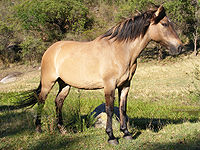
Back Gen dun Catalan Plavák Czech Falbe (Pferd) German Gen dun Spanish سمندی Persian Hallakkoväri Finnish Gène Dun French Turangga ID Falbo Italian 薄墨毛 Japanese
The dun gene is a dilution gene that affects both red and black pigments in the coat color of a horse. The dun gene lightens most of the body while leaving the mane, tail, legs, and primitive markings the shade of the undiluted base coat color. A dun horse always has a dark dorsal stripe down the middle of its back, usually has a darker face and legs, and may have transverse striping across the shoulders or horizontal striping on the back of the forelegs. Body color depends on the underlying coat color genetics. A classic "bay dun" is a gray-gold or tan, characterized by a body color ranging from sandy yellow to reddish brown. Duns with a chestnut base may appear a light tan shade, and those with black base coloration are a smoky gray. Manes, tails, primitive markings, and other dark areas are usually the shade of the undiluted base coat color. The dun gene may interact with all other coat color alleles.


